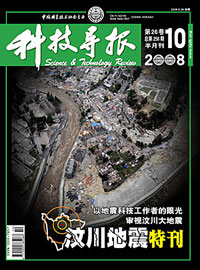| 
On May 18, the China Earthquake Administration revised the magnitude of the Sichuan earthquake from 7.8 to 8.0 on the Richter scale. Chen Yuntai, Repute Director of the Institute of Geophysics with China Earthquake Administration and Member of Chinese Academy of Sciences, explores the reasons behind the revision in an article published in the scientific journal Science and Technology Review. Excerpts follow:
The magnitude of an earthquake is measured on the basis of recorded ground motion intensity. However, clarifying the pattern of how the amplitude of the seismic wave changes is the precondition for measurement, for it varies from site to site (the nearer the place to epicenter, the stronger the shaking). At the same time, the magnitude class should be clarified as well, which means imposing a parameter that describes a magnitude nil earthquake, and then goes up to magnitude 1 or 2 and so forth, by the same standard.
Notably, there are chronic difficulties in earthquake magnitude measurement. Firstly, an earthquake is a complex combination of different factors. The ground motion recorded on the surface is not merely determined by the "size" of the quake; sometimes the local geological, geomorphological and geostructural conditions that the wave propagation reaches also matter a great deal. For instance, the transfer speed of the seismic wave varies depending on stratum and direction. As a result, the amplitude of the seismic wave recorded by seismographs differs from site to site regardless of the same distance to epicenter.
Secondly, the radiated seismic wave differs from direction to direction. An earthquake is mostly the result of sudden cracks and deformation of rocks beneath the Earth's crust, and these create seismic waves. As a result, the amplitude of wave propagation may differ from the east to the north; the intensity measured from different seismic stations varies by the same token. This is the reason magnitudes of an earthquake being recorded from different places around the world often vary. The ideal scenario, if any, would show the same figure everywhere.
Finally, the ways of magnitude measurement vary. Seismologists have to use different scales to measure different earthquakes, for no "scale" has been invented thus far that can measure all earthquakes. The different magnitudes of the Sichuan earthquake recorded by China and the U.S. is an apt example. According to the National Earthquake Information Center (NEIC) of the U.S. Geological Survey (USGS), the magnitude was 7.8 and later revised to 7.9 using the moment magnitude scale. The immediate result from China showed 7.8, and five days later was revised to 8.0 using surface-wave magnitude. Moreover, according to the result of the moment tensor inversion of the aftershocks produced by top Chinese seismologists on May 13, the quake was deemed to be 7.9 or even as high as 8.3 by the moment magnitude scale.
The comparison between the Sichuan earthquake and the magnitude 7.8 (by surface-wave scale) Tangshan earthquake of 1976 is not new to most Chinese people. Both of them claimed tens of thousands of lives and caused devastation in terms of property and infrastructure. The magnitude 7.9 Sichuan earthquake, measured by the moment magnitude scale as mentioned above, is 0.3 greater than the Tangshan earthquake, which means approximately three times as much energy would have been released. In addition, the length of the faults in the Sichuan earthquake is 300 km, three times longer than that of Tangshan earthquake. It is plain to see, with this evidence, that the aftermath of the Sichuan earthquake is far more severe than that of the Tangshan one.
Scientific research is by no means easy and there is still a long way to go, particularly in the field of earthquake prediction. It will benefit seismologists and professionals in related areas to be totally aware of the existing difficulties and challenges that lie ahead. Likewise, using these difficulties as excuses to give up research and studies is inexcusable. |
